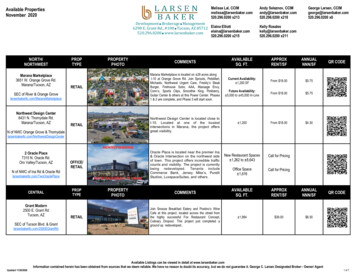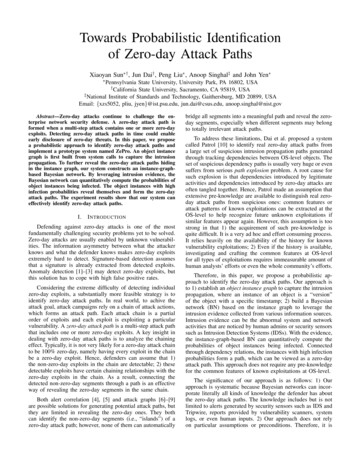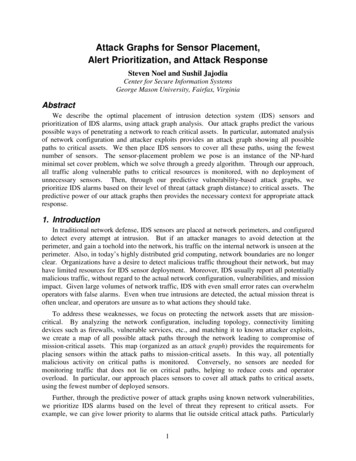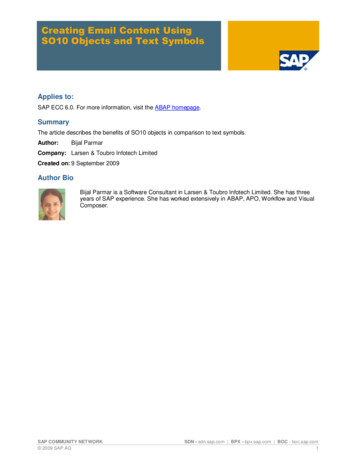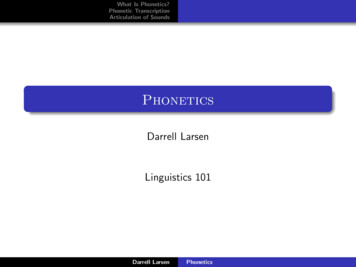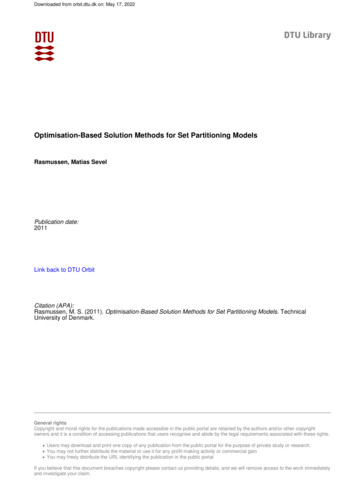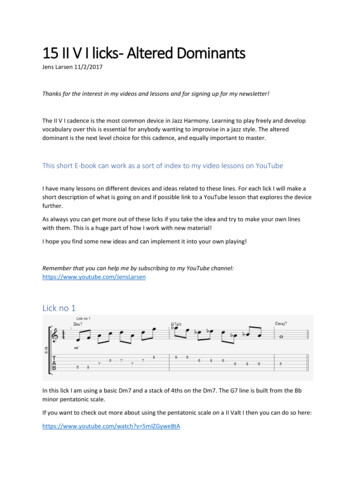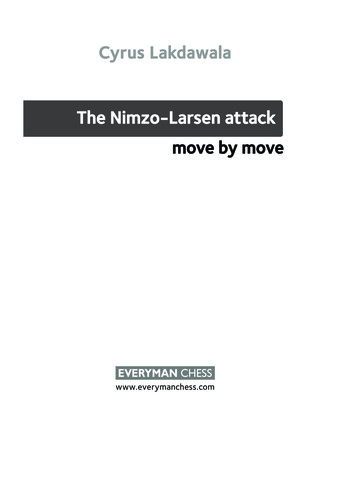
Transcription
Cyrus LakdawalaThe Nimzo-Larsen attackmove by movewww.everymanchess.com
About the AuthorCyrus Lakdawala is an International Master, a former National Open and American OpenChampion, and a six-time State Champion. He has been teaching chess for over 30 years,and coaches some of the top junior players in the US.Also by the Author:Play the London SystemA Ferocious Opening RepertoireThe Slav: Move by Move1.d6: Move by MoveThe Caro-Kann: Move by MoveThe Four Knights: Move by MoveCapablanca: Move by MoveThe Modern Defence: Move by MoveKramnik: Move by MoveThe Colle: Move by MoveThe Scandinavian: Move by MoveBotvinnik: Move by Move
ContentsAbout the Author3Series Foreword5Bibliography6Introduction71Nimzo-Larsen vs. Classical set-up182Lines with .e7-e5 and .d7-d6733The Beginner’s Variation1464Reversed Open Sicilian1925Reversed Nimzo-Indian2256Réti set-ups2587Reversed London, Torre and Trompowsky2858The Trompowsky Nimzo-Larsen3299Nimzo-Larsen vs. Dutch346Odds and Ends360Index of Variations411Index of Games41510
Series ForewordMove by Move is a series of opening books which uses a question-and-answer format. Oneof our main aims of the series is to replicate – as much as possible – lessons between chessteachers and students.All the way through, readers will be challenged to answer searching questions, to testtheir skills in chess openings and indeed in other key aspects of the game. It’s our firm belief that practising your skills like this is an excellent way to study chess openings, and tostudy chess in general.Many thanks go to all those who have been kind enough to offer inspiration, advice andassistance in the creation of Move by Move. We’re really excited by this series and hope thatreaders will share our enthusiasm.John Emms,Everyman Chess5
IntroductionW ][DPDWDWDW][PDP)P)P)][ NGQIBHR]W--------WIn the Prajnaparamita Sutra, the Buddha asks: “Can you count, compare, measure, conceive, imagine, perceive, touch or divide the principle of space? Can you approach, reach orattain space? Can space even be described as infinite?” When you begin a chess game with1 b3, your opponents soon discover that they go to war against a ghost and engage in battles against empty space. If the universe is infinite, then it stands to reason that every possibility – both physical and imagined – must find expression in a manifestation somewhere out there. The Nimzo-Larsen Attack is an opening which fits this theory.Chess is that strange realm where dimensions of form and that of imagination interrelate and mesh. We play 1 b3, a harmless little move, allowing Black a blank canvas, withscope to set up any way he or she desires. On our very first move we challenge the forces oforthodoxy, who claim that we must enter a trendy theoretical line to claim our birthrightWhite advantage. In fact, we cede this point and instead engage in one-on-one combat onraw chess skill, virtually circumventing the entire opening phase (well, apart from some ofthe super-sharp 1.e5 lines of the first three chapters in this book!). After 1 b3, prepare toenter realms where book knowledge grows vague, and where we must survive only by superior adaptability to the constantly shifting structures. In fact, our entire association withthe opening phase (with the exception of a few forcing variations) grows so tenuous that it7
The Nimzo-Larsen Attack: Move by Movevirtually disappears. With our first move we give license to free reign on creativity—bothours and our opponent’s. Immediately after our first move, our future appears as a vacantlot. It is actually our opponent’s response which tells us what to build on that lot. We makeour way through strange terrain of multitudinous possibilities, diverse futures.The Nimzo-Larsen isn’t as much an opening as it is a composite of other openings andstructural possibilities. In hypermodern fashion – a necessary article of faith for our line –we often allow Black to take over the centre with .e7-e5 and .d7-d5, only to attack it laterfrom the sides, and especially pressure it from the vantage point of our fianchettoed b2bishop. Conquest of the central dark squares can be a key criterion of the Nimzo-Larsen.We are our own MessiahThe tendency these days is to look for an openings messiah, order his or her books and thenfaithfully practice the holy teachings. We disaffected Nimzo-Larseners, on the other hand,are sick and tired of waiting around. So we assume the role of our own openings messiah.This book is meant to be a block of suggestions and ideas, not commands to be followed.Most of us tend to play better within a familiar structure. When you open with 1 b3!, morethan likely you alone will be within the familiar after a dozen or so moves, while your opponents will wander about, strangers to the alien environments which tend to arise fromthe Nimzo-Larsen.I view my books as a joint venture in which you, the reader, and I participate. So I neveraccept an opening book contract unless I am willing to play the opening myself. I expectedto take a hit in rating when I first took up 1 b3. In fact in my very first game, I groaned inwardly when I barely drew with a player rated 450 points lower. Then, as I studied and understood the opening more, events began to turn around.In this book you are offered a host of idiosyncratic ideas and flights of fancy – over safer,more solid lines – and I encourage readers to follow their imaginations when playing 1 b3.At this writing, my score with the opening stands at 25 wins, four draws and a loss, froman opposition rated around a 2250 average – a far higher percentage than normal scoreswith my main 1 Ìf3 or 1 d4 lines. Out of these games I achieved very few “ ” positionsafter the opening, and in most games my opponents equalized (and sometimes stood better!). Yet their troubles arose from the middlegame on. So what was the game changer?Opponents tended to react poorly to the bizarrification of the positions, ate up too muchtime on their clocks and began to grow disoriented, which in turn, induced inexplicableerrors from such strong players. Don’t underestimate the weaponization of the outlandish!8
IntroductionW ][DPDWDPDW][PGP)WDP)][ NDQIBHR]W--------WIn this position, the Nimzo-Larsen Blackmar-Diemer Gambit, I had White against GMTamaz Gelashvili at the National Open rapid chess championship. The opening went 1 b3d5 2 Íb2 Íg4 3 f3!? Íf5 4 e4!?. Now my scary strong opponent, rated USCF 2668, lateroutplayed me but I hung on to the draw anyway, mainly because he burned so much of hisclock dealing with a completely new set of opening problems, whereas I banged out mymoves quickly. Why? Because we cover this position in Chapter Seven. So what is bizarreand unfamiliar to the opponent is merely routine, familiar ground for us, the NimzoLarsen clan.The Division of the BookThe book is, in a sense, dissected into two gigantic chapters: 1 b3 e5 lines, and 1 b3 andeverything else lines! Chapters One, Two and Three, the largest in the book, cover the confrontational 1.e5 variations, which you do indeed need to study and, yes, even memorizeparts of, since the lines tend to be forcing and quite mathematical. It is in these lines thatwe are vulnerable to home prep and a crafty opponent’s computer analysis, so we mustwork hardest here in the book. Nevertheless, there is still plenty of room for imagination tofrolic. Then we have Chapters Four through Ten, 1 b3 versus everything else. These linestend not to engage in early confrontation, and therefore allow us to do some really strangethings, which I, your enabler, encourage throughout the book!The History of the Nimzo-LarsenIn the 1920s and 30s, Aaron Nimzowitsch scored over 80% with 1 b3, and 1 Ìf3, 2 b3. Surprisingly, he played the latter 1 Ìf3 move order far more often than the purist 1 b3 version. He mostly got reversed Nimzo-Indian positions, as examined in Chapter Five, whichhe understood more deeply than virtually all his opponents.Larsen, too, did very well with his namesake opening, scoring an impressive 80%, mainly with the 1 b3 move order. Yet, paradoxically, our opening was hit with a terrible setback9
The Nimzo-Larsen Attack: Move by Movesetback from a public relations standpoint, when then world champion Boris Spassky dismantled our hero, Larsen in a mere 17 moves in a high-stakes game at the USSR vs. Rest ofthe World match in Belgrade, 1970. It was painful to watch and not much of a contest. Onthe one side we observed a salivating cat and on the other a quaking hamster. Somehowthis massacre embedded itself in our collective consciousness and now most players associate 1 b3?! with the Larsen-Spassky debacle. I have cunningly hidden this game, embeddedsomewhere in the notes of the book and refuse to annotate this embarrassment – unless,of course, I end up writing Spassky: Move by Move! (In which case I would no doubt extoland wax poetically over the glories of Spassky’s sumptuous attacking skills!)Fischer, in an experimental mood, took up the opening’s mantle in the early 70s, racking up a perfect 5-0 score, an act which injected our Nimzo-Larsen spirits with a considerable boost of confidence – although most players didn’t attribute Fischer’s success to thepowers of the Nimzo-Larsen itself, since at the time Fischer slaughtered opponents at unheard-of margins with every opening. Then there followed four decades of dormancy – alengthy convalescence period (to recover from the Larsen-Spassky game!) – where ouropening was left untouched, like rotten cheese past its expiration date, by the upper echelon of chess.A New, Hallucinatory Era for 1 b3!Fortunately, a violin doesn’t lose its tone if left unplayed by a maestro for a long period oftime. In the present, our hibernating opening awakens to its old power and glory, none theworse for its disuse. Today, we arrive upon the threshold of a new era for our opening. Armenian GM Tigran L. Petrosian and Georgian super-GM – rated over 2700 – Baadur Jobabaplay 1 b3 regularly and with success. Modern GMs interpret the opening in a kind of highend crazy formulation, inspiring a new generation of Nimzo-Larseners. Their play sparkleswith anticipatory, child-like freshness, as we try and guess (almost always incorrectly!)their coming moves.When the Duke of Wellington was asked what his orders were in case he was killed inthe Battle of Waterloo, he responded: “To do like me!” And so now we steal a glimpse of ourtop general’s modern interpretations of our line. (I sneaked in a diagram of one of mygames as well. Okay, fine, I’m not included in the list of top Nimzo-Larsen generals, but Icertainly qualify as newly enlisted zealot in our war!) Here is just a taste of some of the positions examined in the coming chapters. In each case White submerges himself in fancifulnotions and dark alchemies and, in each case, White, the Nimzo-Larsener, functions andpushes forward upon the wind of a fundamentally optimistic premise: I will survive thecomplications and you, my bewildered opponent, won’t – and in each case they were correct! Behold that hallucinatory, strategy-less netherworld, called the Nimzo-Larsen, whereall futures are possible:10
IntroductionW ][DPDW)WDW][PGN)B)W)][ WDQIWHR]W--------WPetrosian-Vishnu (Game 25)W ][DPHW)PDW][PGP)WDWD][ WDQIBDR]W--------WJobava-Yu (Game 45)W ][DPHW)NDP][PGP)WDWD][ WDQIBDR]W--------WJobava-Ma (Game 48)W ][DPHW)WDW][PGP)W)P)][ WDQIBHR]W--------WJobava-Giri (Game 55)11
The Nimzo-Larsen Attack: Move by MoveW ][DPHW)WDW][PGW)B)W)][ WDQIWDR]W--------WKharlov-Ernst (Game 43)W ][DPHW)WDW][PDQ)B)W)][ WDWIWDR]W--------WLakdawala-Krishnan (Game 33)A quick glance at these diagrams and one would believe the book was titled: The Grob:Move by Move! The modern interpretation of the Nimzo-Larsen is a virtual Ìc3/g2-g4-fest!To the naked eye, it appears as if White’s forces in the above positions lie about in disorderly array, like obese sunbathing tourists littered about the beach. In each case, Whiteunscrews the lid, and allows anarchy and unblocked creativity to pour forth and splash asit may.Conversely, watch how Nimzowitsch’s greater understanding of the structure guideshim to the win in the following game:Game 1A.Nimzowitsch-H.JohnerExhibition game, Bern 19311 Ìf3Question: Doesn’t the Nimzo-Larsen begin with 1 b3 - ?Answer: Technically, yes, but some players start the game with 1 Ìf3 and 2 b3. In this book,the vast majority of the games do indeed begin with 1 b3!.Question: Why would White want to avoid the 1 b3 move order?12
IntroductionAnswer: It has the effect of cutting out Black’s sharpest and most theoretical response1.e5, whose lines we covered for nearly half the book. Which means it is also possible toplay the Nimzo-Larsen à la carte.1.Ìf6 2 b3W ][DPDWDNDW][PDP)P)P)][ NGQIBDR]W--------WThere we go. Radical stuff back in 1931. The hypermodern’s philosophy: a preposterousnotion (allow the opponent to take control of the centre, to later attack it from the wings)ceases to bear that label if it can also prove its effectiveness. Sometimes we play a shockingmove (yes, 2 b3 was shocking in 1931), not for its inherent power, as much as for the sheerexhilaration of it.2.d5In the 1920s and 30s virtually every one tossed in the classical .d7-d5 response at somepoint or another. All but a few radical hypermoderns challenged the theory that physicallycontrolling the centre with your pawns was always a positive venture.3 Íb2 c5 4 e3 Ìc6 5 Íb5Reaching a reversed Nimzo-Indian, which we cover extensively in Chapter Five.5.Íg4Not a great line for Black, who usually gets robbed of the bishop pair in this version. Wecover 5.Ëc7, 5.Íd7 and 5.a6 responses in Chapter Five.6 Íxc6 Question: Should White wait for .a7-a6 before swapping on c6?Answer: Not normally. White often takes on c6 unprovoked in this line. However, he candelay by tossing in 6 h3 Íh5?! (I think this natural move almost gives White a winning position; I suppose Black can change his mind and play 6.Íd7 which would hand White anot terribly useful tempo with h2-h3, whereas 6.Íxf3 7 Íxc6 bxc6 8 Ëxf3 gives White apleasant structural edge without the cost of the bishop pair) 7 g4 Íg6 8 Ìe5 Îc8 9 h4!13
The Nimzo-Larsen Attack: Move by Move(White herds pawns to make the structure pliable to his wishes, threatening 10 h5 Íe4 11f3) 9.d4 (9.h5? 10 Ìxg6 fxg6 11 g5 Ìd7 is strategically nauseating for Black, who nursesan awful pawn structure on the kingside, is weak on the light squares, and has handedWhite the bishop pair – normally Black’s birthright in the reversed Nimzo-Indian) 10 Ìxc6bxc6 11 Ía6 Îb8 12 h5 Íe4 13 f3 with a clear structural superiority to White, E.DizdarevicI.Kinez, Pula 1996.6.bxc6 7 h3 Íxf3?!Now White has damaged the opposing queenside for free. At least 7.Íh5 8 g4 (Whitecan also play more quietly with 8 d3 h6 9 Ìbd2) 8.Íg6 9 Ìe5 Ìd7 10 Ìxg6 hxg6 getsBlack an open h-file in exchange for the bishop.8 Ëxf3 Ëc7Recognizing the need to fight for e5.9 d3W ][DPDP)QDP][PGPDW)PD][ NDWIWDR]W--------W9.e6Question: Why didn’t Black play 9.e5 instead?Answer: It violates the principle: Avoid fixing pawns on the same colour as your remainingbishop. White seizes the advantage after 10 Ëg3 Ìd7 11 e4 Îb8 12 Ìc3 Ëd6. And 12.d4?!13 Ìb1! is even better for White, who now controls c4, may later target c5, and is free toconsider both f2-f4 and c2-c3 pawn breaks.10 Ìc3Question: Why can’t White win a pawn here?Answer: It isn’t worth the loss of initiative after 10 Íxf6?! gxf6 11 Ëxf6 Îg8 12 Ëf3 Íg7 13c3 a5.10.Íd6 11 Ìa414
IntroductionGiving notice to Black that c5 is a weak pawn.11.Íe5Reminding White that control over e5 is a privilege, not a right. Swaps hurt Black, buthe had to do something about the b2-bishop’s eternal gaze upon f6.Question: Can Black dissolve the weakness with 11.c4 - ?Answer: He merely trades one problem for another after 12 Íxf6 gxf6 13 dxc4 dxc4 14 0-0f5 15 e4 fxe4 16 Ëxe4 cxb3 17 cxb3, when Black’s pawns – especially c6 – are weak, and hisking looks somewhat insecure as well.12 Íxe5 Ëxe5 13 0-0 Ìd7 14 Ëe2!?Nimzowitsch wants to slide his queen over to the other side of the board in search oftargets. Today’s GMs would undoubtedly play 14 c4, fixing the target on c5.14.0-0 15 Ëd2!? f5Black hopes to get something cooking on the kingside to distract White from the otherwing. 15.a5!? was also possible, keeping White’s queen off that square, albeit at the costof a tempo.16 Ëa5!With this move, Nimzo sends his opponent a message. Not a loud one, but enough toindicate just who is in control of the position.16.Îfb8Instinct, the more powerful force, generally overrides logic in times of crisis. With hislast move Black decides to play for high stakes, refusing to play a defensive move like16.Ëd6.W ][DPDP)WDP][PDPDW)PD][ WDWDRIW]W--------WExercise (critical decision/calculation): Calculate the ramifications of 17 Ìxc5 Îb518 Ìxd7 Ëxa1. Sinister emanations pour forth from c5. Can White take it or not?15
The Nimzo-Larsen Attack: Move by MoveAnswer: White has seen deeper into the position and the move works.17 Ìxc5!!White’s knight frolics about in high spirits, the way your dog acts when you returnhome from a trip. In such positions our likes and dislikes are discarded variables. In mathbased calculations, there is but a single solution to the equation.17.Îb5 18 Ìxd7 Ëxa1 19 Ëc7! Ëc3 20 a4!Nimzo implements an inestimably crucial component to White’s sequence. The rook ischased to a tactically vulnerable square. Those who were aggressors suddenly find themselves in the role of the assailed. It becomes clear that defence of Black’s offside rook willprove to be an enormous drain on his resources.20.Îb4A move which attests to Black’s extreme level of desperation. For now, the rook loafsabout and runs idle, like a computer monitor on sleep mode. Instead:a) 20.Îa5? (this awkward move is slow death for Black) 21 d4! h6 22 Ìe5 Êh8 23 Ìg6 Êg8 24 Ìf4 Îe8 25 Ìh5 mates. Veni vidi vici. In this way White breaks up an oversized,unmanageable whole into scattered, weakened chunks. There is no way to protect g7.b) 20.Ëa5? 21 Ëxc6 Îbb8 22 Ìxb8 Îxb8 23 Ëxe6 Êh8 24 Ëxf5. White continues tosiphon off extraneous black pawns and regains the exchange with four pawns’ interest.21 Ìe5!W ][DP1P)WDP][WDPDW)PD][DWDWDRIW]W--------WNimzo strangles Johner’s joy with each passing move. He threatens c6, as well as Ëf7 ,followed by Ëxe6. White’s attacking queen and knight team swim into the nervous blackking’s line of sight.21.Îf8Or 21.Êh8 22 Ìf7 Êg8 23 Ëe7! Îbb8 (23.Îab8 24 Ìd8! Îxd8 25 Ëxd8 Êf7 26Ëa5! c5 27 Ëc7 Êf6 28 f4 Ëxc2 29 Îf3! Îxb3 30 Îg3 g6 31 Ëxh7 is curtains for Black’sking) 24 Ëxe6 Ëf6 (24.Îe8? walks into the smothered mate combination every Russianfirst grade child knows: 25 Ìh6 Êh8 26 Ëg8 Îxg8 27 Ìf7 mate) 25 Ìh6 Êf8 26 Ëxf6 16
Introductiongxf6 27 Ìxf5 and White should convert with three pawns for the exchange.22 Ìxc6Threatening Ìe7 with a discovered attack on Black’s loose queen.22.Êh8“This too shall pass,” thinks Black’s king of the new wave of White’s attack. Unfortunately, he is mistaken and his position reaches terminal proportions. Johner by now surelyrealizes he is caught under the thrall of a power greater than his own.W ][DP1P)WDP][WDPDW)PD][DWDWDRIW]W--------WBlack nurtures a final, lone hope for survival – a daydream more than a hope. But hislast move overlooks a lethal potential. We sense a foreboding, an absolute finality on thehorizon, as a cat’s face appears to the goldfish in the bowl.Exercise (combination alert): Find one move andyou force Black’s immediate resignation.Answer: Double attack. No need for sparkling tactics when inertia does all the work.23 Ëd6! 1-0Summary: Against the set-up .d7-d5, .c7-c5 and .Ìc6, we get a reversed Nimzo-Indian.AcknowledgementsMany thanks as always to editors John Emms and Jonathan Tait for their insight and suggestions; to comma czar Nancy for her tea-making and proof-reading; and to Tim for hiscomputer backing-uping skills.May your opponent’s eyebrows arch at least half an inch in reproachful bewilderment,and may your imaginations run wild as you open your game with 1 b3!.Cyrus Lakdawala,San Diego, July 201317
Reversed Open Sicilianchief’s insult to his enemy from The Last of the Mohicans: “Reed that bends.the enemyknow the shape of your back, but they have never seen the colour of your eyes. Your namewill never be mentioned again in your tribe – it is already forgotten.”If instead 23.Ëg8 (the queen enters her room and slams the door behind her – her servants wince upon hearing the breaking of glass and the crash of splintering furniture inside) 24 dxe5 Íf7 25 Ìd4 Ìxd4 26 Îxd4 Íe6 27 Ëc6 Íxg4 28 hxg4 Ìf8 29 Îxd8 Îxd8 30Ëxc7 and Black crumbles.24 dxe5 Ìxe5 25 Íxc8Material begins to hang, as a sad corollary to Black’s earlier decisions.25.Îxc8 26 Îd5! 1-0After 26.Íd6 27 Ìxb6, we see the true measure of Black’s misery as Fischer’s piecescrawl in like ants in jam.Summary: Play the 3 c4 move order if you have experience with the Scheveningen Sicilianstructure as Black.Game 30R.J.Fischer-U.AnderssonExhibition game, Siegen 1970In the realm of human achievement, Fischer – psychosis aside – sits among the likes ofda Vinci and Mozart in his field. Games like this remind us why.1 b3 e5 2 Íb2 Ìc6 3 c4 Ìf6 4 e3 Íe7 5 a3 0-0 6 Ëc2Still waiting for .d7-d5 to appear!Question: And if Black refuses to play .d7-d5, then what?Answer: Then we get something similar to Larsen-Andersson from Chapter Two (Game 20),a much slower strategic fight.6.Îe8 7 d3 Íf8 8 Ìf3 a5Come on man, get on with it!9 Íe2 d5Hooray!10 cxd5 Ìxd5 11 Ìbd2 f6199
The Nimzo-Larsen Attack: Move by MoveW ][)PDP)NDW][WGQHB)P)][ WDWIWDR]W--------WQuestion: What differentiates this position from Fischer-Tukmakov?Answer: Tukmakov played the loosening but more aggressive .f7-f5. In this game Andersson, true to his nature, plays the super solid .f7-f6, come-and-get-me formation. He alsotossed in .a7-a5, which weakens b5 but constrains White’s queenside ambitions by preventing b3-b4 expansion ideas.12 0-0 Íe6 13 Êh1!!W ][)PDP)NDW][WGQHB)P)][ WDWDRDK]W--------W“Faith and begorrah!” I muttered to myself, while trying to puzzle out Fischer’s intentwhen I first played over this game at the age of 10. (Which admittedly is a bit odd, since Iam Indian, not Irish. But I was trying to imitate Chief O’Hara, the Irish Gotham City Chief ofPolice from the 1960s’ Batman TV show.)200
Reversed Open SicilianQuestion: A random move from White rewardedwith a double exclamation mark? Please explain.Answer: A completely new plan of immense gravity and far-reaching consequences takesbirth. The double exclam was for the originality of the idea: White plans Îg1 and g2-g4,after which his knight has free reign over e4, as well as a potential attack. Today, everyScheveningen, Najdorf, Kan and Taimanov Sicilian player is aware of such a plan, thanks toFischer. Of course, it entails risk for White as well, since he voluntarily weakens his ownking. But think about this: the only way for Black to disrupt this plan is to pry open the centre – not so easy, since Black’s central structure is rigid for now.13.Ëd7Clearing a path for .Îad8 and making it more difficult for White to engineer g2-g4.14 Îg1 Îad8 15 Ìe4 Ëf7Question: Why did Andersson allow White g2-g4 after all?Answer: I have a feeling Andersson welcomed the g-pawn thrust and didn’t trust Fischer’splan. Black pays a structural price if he attempts to thwart the plan. For example, 15.Ìb616 Ìfd2 and now if Black takes the nuclear option and tosses in 16.f5!?, there is a highcost to his king’s safety:W ][)PDP)WDW][WGQHB)P)][ WDWDW K]W--------Wa) 17 Ìc5! Íxc5 18 Ëxc5 e4 19 g4!? exd3 (19.f4!? 20 Ìxe4 Íxb3 21 Ëg5 favoursWhite) 20 gxf5 Ëd5 21 Ëxd5 Íxd5 22 Íf3 Íxf3 23 Ìxf3 Îd7 and I like White’s chances with his guns trained upon g7, despite Black’s deeply entrenched d3-pawn.b) At first I thought 17 Ìg5 was White’s best, but now I’m not so sure. After 17.Íd5 18e4 Ìd4 19 Íxd4 exd4 20 Íh5! (threatening e8 and also d5) 20.g6 21 exd5 gxh5 22 Ìe6,my intuition tells me this position favours White, but Houdini insists that Black is okay:201
The Nimzo-Larsen Attack: Move by Move22.Îc8 23 Ìf3 Ìxd5 24 Ìxf8 Îxf8 25 Ìxd4 Ìf4 26 Ëc4 Ëd5 27 Ìf3 Ëxc4 28 dxc4 Ìd329 Îa2 and it won’t be so easy to exploit Black’s structural weaknesses, since his powerfuld3-knight compensates somewhat.16 g4W ][)PDP)NDW][WGQDB)W)][ WDWDW K]W--------WGenius is not always bound to precepts. In this case Fischer deliberately violates theprinciple: Avoid weakening your king’s pawn front. Such decisions are played with irreversible intent: come and get me before I get you.16.g6!?Question: Why did Black weaken himself down the a1-h8 diagonal?Answer: Black probably played the move for the following reasons:1. He feared g4-g5, and if .f6-f5, then White may have a g5-g6 zwischenzug whichclears g5 for a knight.2. If White played a future Ìh4, it may have provoked .g7-g6 anyway.3. Black may feel a bit safer if he has a chance to play .Íg7, although this would leavec5 for the e4-knight.17 Îg3!White hopes to procure provisions for a long campaign by transferring resources to thekingside. By lifting the rook, he clears the way for the a1-rook.17.Íg7 18 Îag1 Ìb6Attacking b3.19 Ìc5Covering b3, attacking b7, and threatening to pick off the bishop pair.19.Íc8 20 Ìh4! Ìd7 21 Ìe4White’s attack sits on the border of effective and inadequate, and for now remains indeterminate. The black king’s safety and White’s surrounding forces weigh evenly on thescale – until:202
Reversed Open Sicilian21.Ìf8?21.Êh8! prevented White’s next move.W ][)PDP)W W][WGQDB)W)][DWDWDW K]W--------WQuestion: I fail to understand the purpose of White’smassive build-up on the g-file. Where is his breakthrough?Answer: Up to now, White’s kingside forays have only had the effect of nettling Black, morethan inflicting any real damage. So let’s turn this question into an exercise:Exercise (planning): Black’s last move was an error and now, imperceptibly, White’sstrategic pressure yields dividends. How can White make significant progress?Answer: Fischer’s tactic enables him to eliminate a key defender of the dark squares.22 Ìf5!What began as a once promising defensive barrier suddenly displays signs of a potential rout. Now the attack surges forth, as if with a life of its own.22.Íe622.gxf5? loses to 23 gxf5 Íxf5 24 Îxg7 Ëxg7 25 Ìxf6 ! (this zwischenzug destroysBlack) 25.Êf7 26 Îxg7 Êxg7 27 Ìxe8 .23 Ìc5 Ìe7?Now something just doesn’t feel right in Black’s position, the same way a tiger gazesupon a raw slab of meat, swinging suspiciously from a rope in the forest. Black should tryto minimize his disadvantage with 23.Ìd7 24 Ìxe6 Ëxe6 25 d4! (threatening Íc4)25.Ìb6 26 dxe5 fxe5 27 Ìxg7 Êxg7 28 f4, when Black remains in an unpleasant but stillplayable position.24 Ìxg7The old black dark-squared bishop, condemned for heresy, distressingly finds himself203
The Nimzo-Larsen Attack: Move by Movetied to a flaming stake, unable even to cross himself in his agony.24.Êxg7The trouble with 24.Ëxg7? is that White can simply take on b7 now with 25 Ìxb7Íd5 26 Íf3.25 g5Of course. Fischer ruthlessly tears down the already weakened dark squares around Andersson’s king.25.Ìf5 26 Îf3 b6 27 gxf6 Êh8!Black’s only hope is to use White’s f6-pawn as a shield. 27.Ëxf6? 28 Ìe4 Ëe7 29Íxe5 is totally hopeless for Black.28 Ìxe6 Îxe6W ][)PDP)RDW][WGQDB)W)][DWDWDW K]W--------WBlack’s defenders remain in a loose confederation of disconsolate clusters, all vulnerable, all ineffective.Exercise (planning): Find a forcing way toincrease White’s already significant advantage.Answer: Principle: Open the position when you own the bishop pair.29 d4! exd4 30 Íc4 d3After 30.dxe3 31 Îxf5! Îd2 32 Ëc1 gxf5 33 Îg7 Ëe8 (the queen flails about like a beetle on its back) 34 f7! clears the a1-h8-diagonal and mates.31 Íxd3 Îxd3Complete desperation, but 31.Ìd6 32 h4! and h4-h5! is crushing.32 Ëxd3 Îd6 33 Ëc4!Principle: Swap pieces when ahead in material.33.Ìe633.Ëxc4 34 bxc4 Îd2 35 Íe5 (threatening 36 Îxf5! gxf5 37 f7 mate) 35.h5 36 Íxc7 istotally hopeless.204
Reversed Open Sicilian34 Íe5 Îd8W ][)PDW)RDW][WDWDW)W)][DWDWDW K]W--------WIn a situation of macabre foreboding, Black’s helpless king can do no more than glaremelancholy accusation at the growing number of attackers gathering around him. Securing immediate victory is a moment’s work, but only if you work out the combination.Exercise (combination alert): Fischer’s next move, 35 h4, is winningbut not the best. The g-file represents a potential gateway into Black’sposition. The question is: how can White enlarge the aperture of entry?35 h4Answer: Three conspirators
The Nimzo-Larsen Attack is an opening which fits this theory. Chess is that strange realm where dimensions of form and that of imagination interre-late and mesh. We play 1 b3, a harmless little move, allowing Black a blank canvas, with scope to set up any way he or she desires. On our very first move we challenge the forces of
